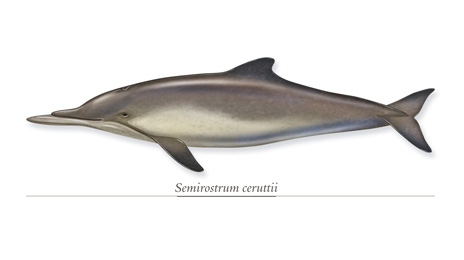
Scientists have identified a new species of ancient porpoise with a chin length unprecedented among known mammals, and suggest the animal used the tip of its face to probe the seabed for food.
Related to living crown porpoises, the extinct Californian porpoise, Semirostrum ceruttii, had an extension of its jaw called a symphysis — the analogue of the human chin — that measured 85 centimeters in the best-preserved specimen, researchers said. The typical symphysis of a crown porpoise measures one or two centimeters.
“This is unique anatomy for a mammal,” said Rachel Racicot, the Yale doctoral candidate who is lead author of a paper about the research, published March 13 in the journal Current Biology. “And it tells us that porpoises once searched for food in a very different way than they do now.”
The paper is the most thorough description ever of Semirostrum and the first to make the case that the porpoise was a benthic feeder, or an animal that dug for food lodged in the seabed. Modern porpoises seek food throughout the water column, preferring in-shore, bottom-dwelling, and mid-water prey, including fish and cephalopods.
Semirostrum is known from about 15 fossil specimens, all from California, including a remarkably well-preserved holotype specimen found at a construction site in San Diego. The species lived roughly 1.5 to 5.3 million years ago along at least 450 kilometers of the California coast.
The name Semirostrum ceruttii refers to the animal’s unusual jaw — the rostrum is the lower (bottom) half of the jaw. The best-preserved specimen was originally retrieved by Richard A. Cerutti, a paleontologist at the San Diego Natural History Museum.
The closest jaw structure in living animals is found in birds known as skimmers (Rynchops) and in half-beak fish (Hemiramphus). As Black Skimmers hunt for food, they fly just above the surface of water bodies with their symphysis slightly submerged to probe and scoop small fish and crustaceans. Both skimmers and half-beak fish feed mainly at night, suggesting the importance to them of highly sensitive probes that can relay through touch information about unseen prey.
Racicot and her collaborators analyzed original fossils and CT scans of the best-preserved specimen, which she describes as “almost completely preserved.” The scans reveal extensive nerve canals leading from the symphysis into the rear of the skull, indicating that the protuberance was highly sensitive and could relay meaningful information to the animal’s brain.
Co-authors are Thomas A. Demére of the San Diego Natural History Museum, Brian L. Beatty of NYIT College of Osteopathic Medicine, and Robert W. Boessenecker of the University of Otago (New Zealand) and the University of California at Berkeley.
The holotype, or archetypal specimen, is in part of the collection the San Diego Museum of Natural History.
The National Science Foundation provided primary research support.
Porpoises and dolphins are closely related within a family that also includes beluga and narwhal.